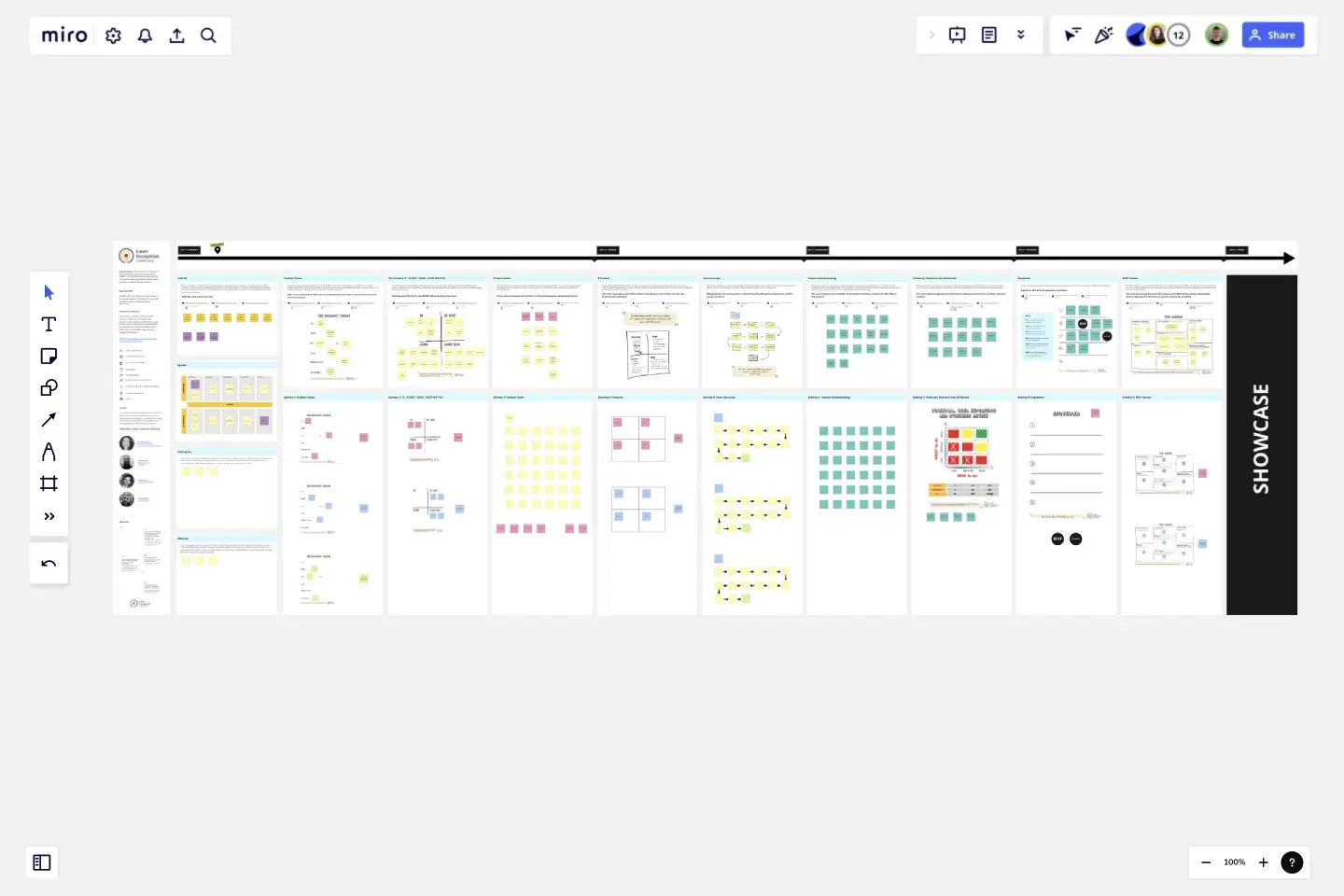Lean Inception Workshop
The Lean Inception workshop template offers a comprehensive series of activities, typically scheduled over the course of a week that helps teams understand, align and plan the building of the MVP – Minimum Viable Product – and the product increments.
When to use The Lean Inception template?
As a product leader or facilitator, you want to align the different perspectives – business, User eXperience and technical – to achieve best product development possible right now.The Lean Inception workshop is highly recommended in two main circumstances.
Large projects find a lean inception valuable to start quickly and be oriented to work in a lean style. Such a start builds early iterations designed to discover and test what features are truly valued by their users.
Smaller organizations (such as startups) use lean inceptions to take an idea that's been tested by some pre-software MVPs and evolve it into a software product.
This workshop is specifically about understanding an MVP, it doesn't substitute for ideation sessions, customer research, architectural review, or competitive analysis. It's one specific technique that's part of understanding what it takes to build a successful product.
How does The Lean Inception template work?
You’ll be guided through a 5-day workshop with a comprehensive step-by-step instruction and facilitation tips for each activity:
Day 1: Kick-off; Product Vision; Is- Is Not – Does – Does not do; Product Goals.
Day 2: Personas; User journeys.
Day 3: Features Brainstorming; Business, UX and Technical Review.
Day 4: Journeys and Feature; Sequencer
Day 5: MVP Canvas; Showcase.
This template was created by Paulo Caroli.
Get started with this template right now.
Miro Basics: Guide for New Participants
Works best for:
Agile
The Miro Basics: Guide for New Participants template offers a comprehensive overview of essential Miro functionalities and best practices for new users. It provides step-by-step instructions, tips, and examples to help participants navigate the Miro platform confidently and effectively. This template empowers new users to leverage Miro's collaborative features and unleash their creativity in visual collaboration. By promoting proficiency and engagement, the Miro Basics: Guide for New Participants enhances collaboration and productivity across teams.
UML Communication Diagram Template
Works best for:
Software Development, Mapping, Diagrams
Most modern programs consist of many moving parts working to a precise set of instructions. With a communication diagram, you can visualize exactly how those parts work together, giving you a clearer understanding of your program as a whole. What’s more, the diagram leaves spaces for expanding the network of relationships as your product grows and evolves. A communication diagram is a vital tool in any software designer’s arsenal.
The Hot Air Balloon Retrospective
The Hot Air Balloon is a simple activity for helping the team identify things that makes them move faster, and things that slow them down.
Customer Journey Mapping Template Pack
Works best for:
Mapping, User Experience, Workshops
A customer journey map (CJM) is a visual representation of your customer’s experience. It allows you to capture the path that a customer follows when they buy a product, sign up for a service, or otherwise interact with your site. Most maps include a specific persona, outlines their customer experience from beginning to end, and captures the potential emotional highs and lows of interacting with the product or service. Use this template to easily create customer journey maps for projects of all kinds.
Good, Bad, Ideas, Action, Kudos Retrospective
Works best for:
Retrospectives, Meetings, Agile Methodology
The Good, Bad, Ideas, Action, Kudos Retrospective template offers a structured approach to retrospectives by categorizing feedback into five key areas: good, bad, ideas, action items, and kudos (appreciations). It provides elements for team members to share their thoughts, suggestions, and acknowledgments. This template enables teams to reflect on past performance, generate actionable insights, and celebrate achievements. By promoting inclusivity and constructive feedback, the Good, Bad, Ideas, Action, Kudos Retrospective empowers teams to foster collaboration, drive continuous improvement, and strengthen team dynamics effectively.
User Persona Template
Works best for:
Marketing, Desk Research, User Experience
A user persona is a tool for representing and summarizing a target audience for your product or service that you have researched or observed. Whether you’re in content marketing, product marketing, design, or sales, you operate with a target in mind. Maybe it’s your customer or prospect. Maybe it’s someone who will benefit from your product or service. Usually, it’s a whole collection of personalities and needs that intersect in interesting ways. By distilling your knowledge about a user, you create a model for the person you hope to target: this is a persona.
